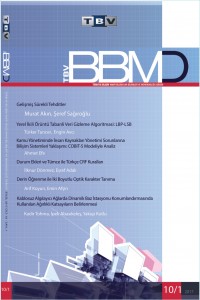Öz
Virüsler,
solucanlar ve casus yazılımlar üzerinden yapılan saldırıların yanı sıra son
birkaç yıl içerisinde geliştirilen ve adına gelişmiş sürekli tehditler denilen
tamamen hedefe odaklı, iyi şekilde düzenlenmiş ve organize olmuş ve en önemlisi
arkasında büyük kuruluşlar, devletler veya destekler olduğu bilinen yeni bir
saldırı türü ortaya çıkmıştır. Bu
çalışmada gelişmiş sürekli tehditler incelenmiş olup gelişmiş sürekli
tehditlerin genel yapısı ve karakteristik özellikleri araştırılmış, geçmiş
dönemde yapılan saldırılar ele alınarak, saldırı sonunda hedeflenen sonuçlara
ne kadar ulaşabildiği değerlendirilmiştir. Son olarak bu tip tehditlere karşı
alınabilecek önlemler sunulmuştur.
Anahtar Kelimeler
Kaynakça
- [6] Mouton, F., Leenen, L., Venter, H.S., “Social engineering attack examples, templates and scenarios”, Computers & Security, vol. 59, pp. 186-209,2016.
- [7] Krombholz, K., Hobel, H., Huber, M., Weippl, E., “Advanced Social Engineering Attacks”, Journal of Information Security and Applications, vol.22, pp.113-122, 2015.
- [8] Auty M., “Anatomy of Advanced Persistent Threat”, Network Security, vol. 2015(4), pp.13-16, 2015.
- [9] İnternet: “Advanced Persistent Threats: A Decade in Review”, URL: http://www.webcitation.org/query?url=http%3A%2F%2Fwww.commandfive.com%2Fpapers%2FC5_APT_ADecadeInReview.pdf&date=2015-12-27 Son Erişim Tarihi:27 Aralık 2015.
- [10] Denning E.D., “Framework and principles for active cyber”, Computers & Security, vol. 40, pp.108-113, 2014.
- [6] Mouton, F., Leenen, L., Venter, H.S., “Social engineering attack examples, templates and scenarios”, Computers & Security, vol. 59, pp. 186-209,2016.
- [7] Krombholz, K., Hobel, H., Huber, M., Weippl, E., “Advanced Social Engineering Attacks”, Journal of Information Security and Applications, vol.22, pp.113-122, 2015.
- [8] Auty M., “Anatomy of Advanced Persistent Threat”, Network Security, vol. 2015(4), pp.13-16, 2015.
- [9] İnternet: “Advanced Persistent Threats: A Decade in Review”, URL: http://www.webcitation.org/query?url=http%3A%2F%2Fwww.commandfive.com%2Fpapers%2FC5_APT_ADecadeInReview.pdf&date=2015-12-27 Son Erişim Tarihi:27 Aralık 2015.
- [10] Denning E.D., “Framework and principles for active cyber”, Computers & Security, vol. 40, pp.108-113, 2014.
Öz
Kaynakça
- [6] Mouton, F., Leenen, L., Venter, H.S., “Social engineering attack examples, templates and scenarios”, Computers & Security, vol. 59, pp. 186-209,2016.
- [7] Krombholz, K., Hobel, H., Huber, M., Weippl, E., “Advanced Social Engineering Attacks”, Journal of Information Security and Applications, vol.22, pp.113-122, 2015.
- [8] Auty M., “Anatomy of Advanced Persistent Threat”, Network Security, vol. 2015(4), pp.13-16, 2015.
- [9] İnternet: “Advanced Persistent Threats: A Decade in Review”, URL: http://www.webcitation.org/query?url=http%3A%2F%2Fwww.commandfive.com%2Fpapers%2FC5_APT_ADecadeInReview.pdf&date=2015-12-27 Son Erişim Tarihi:27 Aralık 2015.
- [10] Denning E.D., “Framework and principles for active cyber”, Computers & Security, vol. 40, pp.108-113, 2014.
- [6] Mouton, F., Leenen, L., Venter, H.S., “Social engineering attack examples, templates and scenarios”, Computers & Security, vol. 59, pp. 186-209,2016.
- [7] Krombholz, K., Hobel, H., Huber, M., Weippl, E., “Advanced Social Engineering Attacks”, Journal of Information Security and Applications, vol.22, pp.113-122, 2015.
- [8] Auty M., “Anatomy of Advanced Persistent Threat”, Network Security, vol. 2015(4), pp.13-16, 2015.
- [9] İnternet: “Advanced Persistent Threats: A Decade in Review”, URL: http://www.webcitation.org/query?url=http%3A%2F%2Fwww.commandfive.com%2Fpapers%2FC5_APT_ADecadeInReview.pdf&date=2015-12-27 Son Erişim Tarihi:27 Aralık 2015.
- [10] Denning E.D., “Framework and principles for active cyber”, Computers & Security, vol. 40, pp.108-113, 2014.
Ayrıntılar
| Bölüm | Makaleler(Araştırma) |
|---|---|
| Yazarlar | |
| Yayımlanma Tarihi | 3 Ekim 2017 |
| Yayımlandığı Sayı | Yıl 2017 Cilt: 10 Sayı: 1 |
Kaynak Göster
https://i.creativecommons.org/l/by-nc/4.0Makale Kabulü | |
Çevrimiçi makale yüklemesi yapmak için kullanıcı kayıt/girişini kullanınız. Dergiye gönderilen makalelerin kabul süreci şu aşamalardan oluşmaktadır: 1. Gönderilen her makale ilk aşamada en az iki hakeme gönderilmektedir. 2. Hakem ataması, dergi editörleri tarafından yapılmaktadır. Derginin hakem havuzunda yaklaşık 200 hakem bulunmaktadır ve bu hakemler ilgi alanlarına göre sınıflandırılmıştır. Her hakeme ilgilendiği konuda makale gönderilmektedir. Hakem seçimi menfaat çatışmasına neden olmayacak biçimde yapılmaktadır. 3. Hakemlere gönderilen makalelerde yazar adları kapatılmaktadır. 4. Hakemlere bir makalenin nasıl değerlendirileceği açıklanmaktadır ve aşağıda görülen değerlendirme formunu doldurmaları istenmektedir. 5. İki hakemin olumlu görüş bildirdiği makaleler editörler tarafından benzerlik incelemesinden geçirilir. Makalelerdeki benzerliğin %25’ten küçük olması beklenir. 6. Tüm aşamaları geçmiş olan bir bildiri dil ve sunuş açısından editör tarafından incelenir ve gerekli düzeltme ve iyileştirmeler yapılır. Gerekirse yazarlara durum bildirilir.
|



